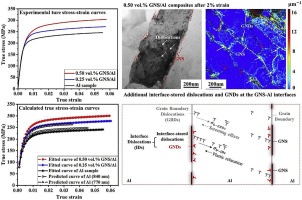Our official English website, www.x-mol.net, welcomes your
feedback! (Note: you will need to create a separate account there.)
Interface-induced strain hardening of graphene nanosheet/aluminum composites
Carbon ( IF 10.5 ) Pub Date : 2019-05-01 , DOI: 10.1016/j.carbon.2019.01.094 Yuanyuan Jiang , Run Xu , Zhanqiu Tan , Gang Ji , Genlian Fan , Zan Li , Ding-Bang Xiong , Qiang Guo , Zhiqiang Li , Di Zhang
Carbon ( IF 10.5 ) Pub Date : 2019-05-01 , DOI: 10.1016/j.carbon.2019.01.094 Yuanyuan Jiang , Run Xu , Zhanqiu Tan , Gang Ji , Genlian Fan , Zan Li , Ding-Bang Xiong , Qiang Guo , Zhiqiang Li , Di Zhang

|
Interface effect was a key mechanism for the deformation of metal matrix composites, which has not been well understood yet in those reinforced with nanoreinforcements. In this study, we prepared graphene nanosheet reinforced aluminum (GNS/Al) composites exhibiting improved tensile strength from 233 to 287 MPa while retaining good uniform elongation from 5.5 to 5.8% compared with the unreinforced Al, thanks to the interface-induced strain hardening capability. The strain hardening behaviors of the GNS/Al composites were discussed in terms of forest hardening and back stress hardening by using the tensile loading-unloading tests and further quantitatively analyzed through a modified strain hardening model based on the dislocation behaviors, where the contributions of grain boundaries and interfaces were distinguished. It turns out that the interface-induced forest hardening was the main reason for improving the strain hardening capability and uniform elongation of the GNS/Al composites. Microstructural characterization revealed that, the additional strain hardening capability of the composites should be from the higher dislocation storage capability of the GNS-Al interfaces than Al grain boundaries and the accommodation of geometrically necessary dislocations near the GNS-Al interfaces. The present work provides a new insight to the design of both strong and ductile metal matrix nanocomposites.
中文翻译:

石墨烯纳米片/铝复合材料的界面诱导应变硬化
界面效应是金属基复合材料变形的关键机制,在用纳米增强材料增强的那些中尚未得到很好的理解。在这项研究中,我们制备了石墨烯纳米片增强铝 (GNS/Al) 复合材料,由于界面诱导应变硬化能力,与未增强的 Al 相比,其拉伸强度从 233 MPa 提高到 287 MPa,同时保持良好的均匀伸长率从 5.5% 到 5.8% . 通过拉伸加载-卸载试验从森林硬化和背应力硬化的角度讨论了 GNS/Al 复合材料的应变硬化行为,并通过基于位错行为的修正应变硬化模型进一步定量分析,其中晶粒的贡献边界和界面被区分。结果表明,界面诱导森林硬化是提高 GNS/Al 复合材料应变硬化能力和均匀伸长率的主要原因。微观结构表征表明,复合材料的额外应变硬化能力应该来自 GNS-Al 界面比 Al 晶界更高的位错存储能力以及 GNS-Al 界面附近几何必要位错的适应。目前的工作为强韧和韧性金属基纳米复合材料的设计提供了新的见解。复合材料的额外应变硬化能力应该来自 GNS-Al 界面比 Al 晶界更高的位错存储能力以及 GNS-Al 界面附近几何必要位错的适应。目前的工作为强韧和韧性金属基纳米复合材料的设计提供了新的见解。复合材料的额外应变硬化能力应该来自 GNS-Al 界面比 Al 晶界更高的位错存储能力以及 GNS-Al 界面附近几何必要位错的适应。目前的工作为强韧和韧性金属基纳米复合材料的设计提供了新的见解。
更新日期:2019-05-01
中文翻译:

石墨烯纳米片/铝复合材料的界面诱导应变硬化
界面效应是金属基复合材料变形的关键机制,在用纳米增强材料增强的那些中尚未得到很好的理解。在这项研究中,我们制备了石墨烯纳米片增强铝 (GNS/Al) 复合材料,由于界面诱导应变硬化能力,与未增强的 Al 相比,其拉伸强度从 233 MPa 提高到 287 MPa,同时保持良好的均匀伸长率从 5.5% 到 5.8% . 通过拉伸加载-卸载试验从森林硬化和背应力硬化的角度讨论了 GNS/Al 复合材料的应变硬化行为,并通过基于位错行为的修正应变硬化模型进一步定量分析,其中晶粒的贡献边界和界面被区分。结果表明,界面诱导森林硬化是提高 GNS/Al 复合材料应变硬化能力和均匀伸长率的主要原因。微观结构表征表明,复合材料的额外应变硬化能力应该来自 GNS-Al 界面比 Al 晶界更高的位错存储能力以及 GNS-Al 界面附近几何必要位错的适应。目前的工作为强韧和韧性金属基纳米复合材料的设计提供了新的见解。复合材料的额外应变硬化能力应该来自 GNS-Al 界面比 Al 晶界更高的位错存储能力以及 GNS-Al 界面附近几何必要位错的适应。目前的工作为强韧和韧性金属基纳米复合材料的设计提供了新的见解。复合材料的额外应变硬化能力应该来自 GNS-Al 界面比 Al 晶界更高的位错存储能力以及 GNS-Al 界面附近几何必要位错的适应。目前的工作为强韧和韧性金属基纳米复合材料的设计提供了新的见解。











































 京公网安备 11010802027423号
京公网安备 11010802027423号